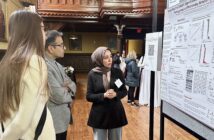Med students aim to treat the most basic ailment: loneliness.
Being in a hospital can be difficult, painful, and oftentimes overwhelming for patients. But those without any family members or friends to visit them may face the extra burden of loneliness when they’re already at their lowest point.
To combat this isolation, the Brown Students at the Bedside Program pairs patients in the hospital who have no visitors with medical students. These students, often in their preclinical years, will spend 30 minutes to an hour sitting with a patient and talking, watching TV, or just keeping them company.
“We care for patients in all stages of life who have limited social support, and that could be for a lot of reasons. Sometimes the patient has no one in their lives or they have family that are far away and can’t come be with them,” Katie DeCarli RES’19, MD, MBE, says. “It’s a vulnerable time for patients when they’re ill enough to be in the hospital. We saw a need to provide those patients with some companionship.”
Physicians are trained to treat and diagnose medical issues, but emotional wellbeing plays an important role, too. Brown Students at the Bedside aims to fulfill that need. “We see patients as people,” says Cynthia Peng MD’20, who plays music for patients as part of another program, Healing Through Harmony. “At the fundamental basis, that’s what we do.”
When a patient is admitted and a member of the medical team notices they have no one with them, they ask if the patient would like a student visitor. If they say yes, the team recruits a medical student. For preclinical students, being able to spend more time in the hospital and talk with a patient one-on-one is invaluable.
“This is a way for us to start helping patients and we learn while we do it,” Dan Kraft MD’22 says. “It’s a two-way street. We’re learning and thinking critically about what it means to care for people, and not just their diseases—and that’s useful for everyone.”
“Students learn about physical diagnosis, but at the early stages in medical school, to sit down and to really interact and get to know who a patient is, what they value, if they’re suffering and lonely, is important,” says Fred Schiffman, MD P’96 MD’00, the Sigal Family Professor of Humanistic Medicine. “To just be able to reach down to patients’ human core is something very special for students and patients alike.”
The program is flexible to prioritize patients’ desires. There is no set curriculum or assignment; instead, students respond to what the patient wants to do. While some patients wish to talk, others simply prefer to sit with someone.
“I visited an agitated elderly woman with dementia who was hard of hearing. Instead of talking, we just sat together and watched TV. Whenever she didn’t understand what was happening, I would help her out. It was my presence that was important there, not the conversation,” Kraft says. He says that after he left, her care team told him that her agitation had significantly decreased. “Sometimes agitation is a sign of suffering,” he adds. “If we can ease that pain, that’s useful for both the patient and the entire medical team.”
The program is in place at Rhode Island Hospital, The Miriam Hospital, and HopeHealth Hospice. The leadership team, which includes medical students, residents, and faculty advisers, hopes to ensure all hospital patients have someone to visit them.
“The act of talking to someone is a beautiful and simple thing,” Peng says. “Having that humanistic touch and reminding people of this fundamental truth—that we treat the patient first—is so important for trainees.”




